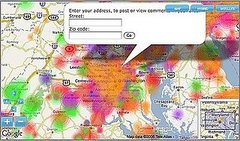CellReception.com Map Is Not Working
Consumer Generated Cell Phone Coverage Maps

How To Check For Cell Phone Coverage By Address
When it comes to choosing the best mobile operator, most people think of the Big Three. The Big Four are known as AT&T, Verizon, T-Mobile / Sprint. However, but they should also include a number of other smaller MVNO carriers that use these major networks.
All four networks are available in the US, with AT&T, Verizon, T-Mobile, Sprint each having their own LTE networks. According to paid studies most carriers will claim they have coverage everywhere but we know this is not true. Coverage only matters at your home address and the only way to check this is by asking someone else in your area, trying it out, or by looking at coverage complaints submitted by customers on the cell phone coverage reviews map above or on the check cell coverage by address mobile map.
You can search this map to see which areas have the worst overage on each of the four major networks in the United States. Use the small search circle in the lower left-hand corner of the map. This map allows you to filter coverage reviews of all major mobile networks by simply clicking on the carrier on the right-hand side of the map.
Enter your country, city, postal code, home or office address select your current location, filter by carrier type and region, and select the best and worst coverage in your area for each of the four major networks in the United States. In this example, you choose one of four different types of mobile towers for the USA and specify a country.
Use can other tools like RootMetrics, OpenSignal, CellReception.com, or SignalMap to see what others are reporting about the range of the operator in your area based on positive signal strength. However, these providers do not allow you to provide reviews on carriers in specific locations. There is also a map to look at cellular towers and antenna locations nearby.
RootMetrics does not have a map of the mobile towers in the viewfinder, but in some areas, it shows the cell signal quality. Although Root Metrics does not have a map of mobile towers, it is a strong indicator of signal quality in your area.
T-Mobile Tower Map lets you enter your zip code, locate a location on the map, and see if 4G LTE coverage is available. Search for T-Mobile 5G coverage from your current location, and it's available in all 50 states and Puerto Rico.
Sprint gives you the ability to look up any address you want and allows you to see the coverage that's in your location. To access the website you are using, such as T-Mobile Tower Map, first, enter your address in the search engine of our website. Go to our mobile phone comparison engine and check the coverage at your exact location, and you will begin to gain a better understanding of coverage at the sites you are using.
AOL Patch is Trying to Copy Our Business
Compare Cell Phone Reception Maps
1) Try searching for comments by carrier
2) Try finding a location by zip code, address, city, state
3) Try submitting a coverage complaint and comment.

Popular Posts
-
Boost Mobile Coverage Map Boost Mobile is a prepaid wireless service provider in the United States. It offers no-contract cell phone ...
-
As WiFi becomes more essential to modern homes, many people wonder how far a WiFi router should be from their sleeping area for safety and...
-
In the rapidly evolving world of mobile connectivity, choosing the right network provider can be daunting. With giants like Verizon, AT...
-
Which State Get The Most Cell Phone Coverage Complaints?
-
Experiencing full bars on your cell phone display but no service can be attributed to several factors:
-
AT&T is one of the largest wireless service providers in the United States, offering a variety of service plans and extensive covera...
-
Starlink, the brainchild of billionaire entrepreneur Elon Musk, is revolutionizing global broadband access using an ever-expanding network o...
-
Cell phone service has become an indispensable aspect of daily life. From communication to accessing essential information, the reliability ...
-
Consumer Cellular Coverage Maps on AT&T Consumer Cellular is a prepaid wireless MVNO that operates on AT&T's & T-Mobile...
-
Verizon Wireless is one of the largest wireless service providers in the United States, offering a wide range of mobile plans and exten...

















